Cross-Cultural Management: Cultural Dimensions, Intelligence & Stats
VerifiedAdded on 2023/06/07
|10
|2532
|126
Report
AI Summary
This assignment is a reflective journal focusing on cross-cultural management. It begins by explaining Trompenaars' Onion Model and its seven dimensions of culture, applying this model to the author's Nepali culture, highlighting particularism, communitarianism, emotional expression, specificity, ascription, synchronous time orientation, and external direction. It discusses how statistical data on population demographics assists international managers in decision-making by providing insights into cultural practices and values. The report defines cultural intelligence, emphasizing its importance in cross-cultural environments and the author reflects on their own cultural intelligence, attributing their high cultural competency to their Nepali background and extensive social interactions. It further discusses Wesfarmers' six corporate values, including ethical considerations, legal compliance, customer centricity, respect for suppliers, employee respect and accountability, and societal contribution. The author concludes with a reflection on how continuous skill development and accountability can make an individual indispensable in the corporate environment. Desklib provides access to similar documents and study resources for students.
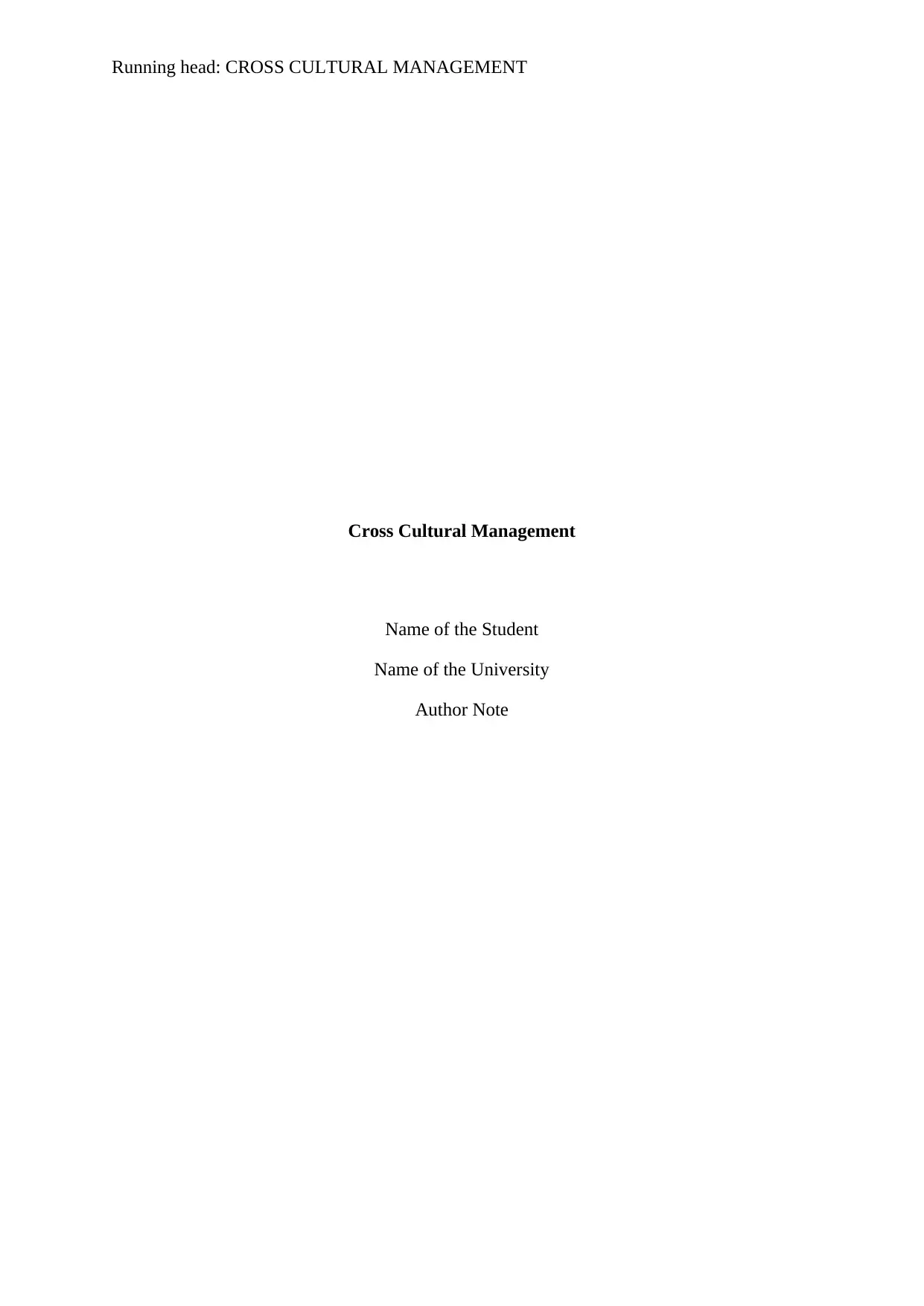
Running head: CROSS CULTURAL MANAGEMENT
Cross Cultural Management
Name of the Student
Name of the University
Author Note
Cross Cultural Management
Name of the Student
Name of the University
Author Note
Paraphrase This Document
Need a fresh take? Get an instant paraphrase of this document with our AI Paraphraser
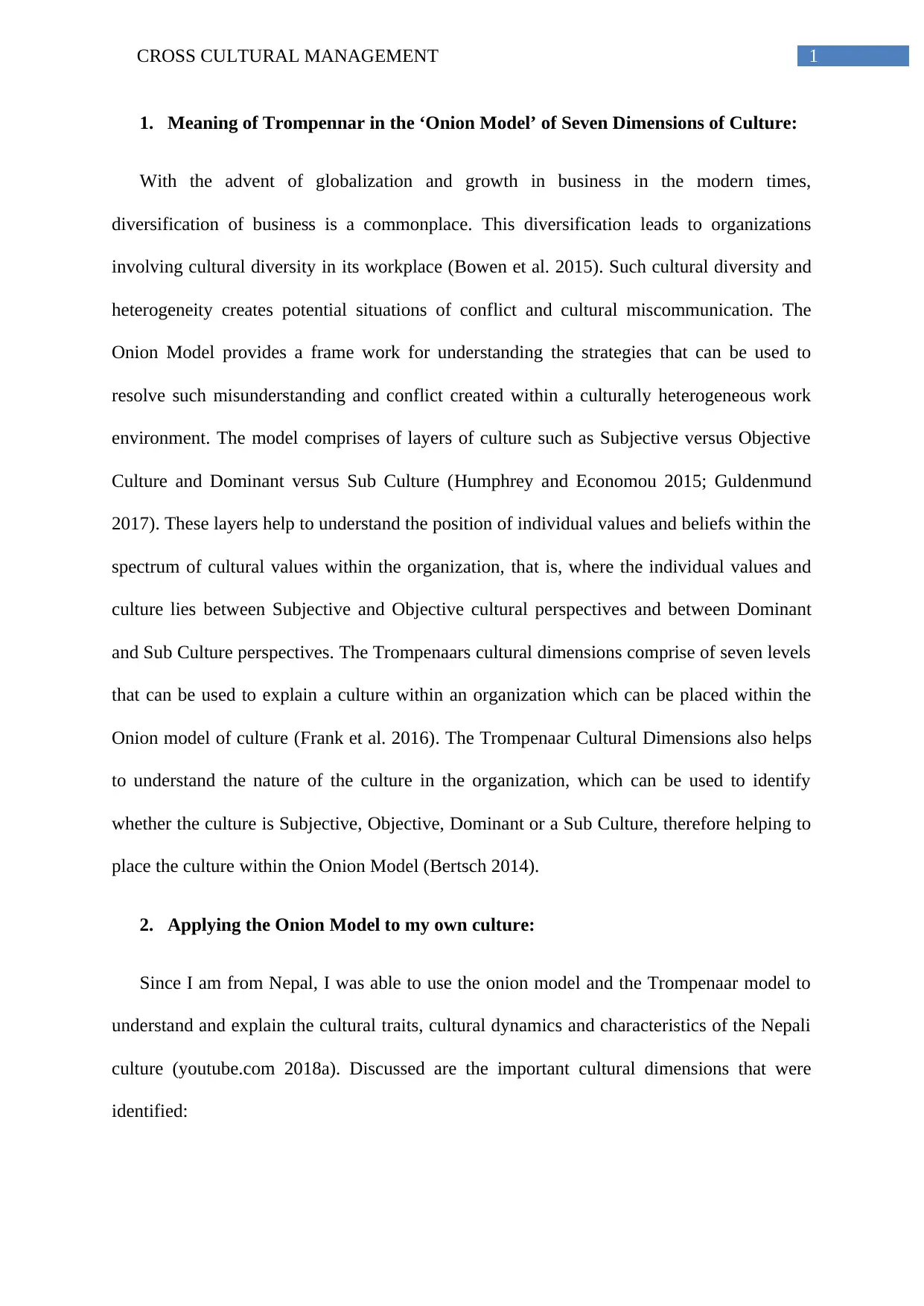
1CROSS CULTURAL MANAGEMENT
1. Meaning of Trompennar in the ‘Onion Model’ of Seven Dimensions of Culture:
With the advent of globalization and growth in business in the modern times,
diversification of business is a commonplace. This diversification leads to organizations
involving cultural diversity in its workplace (Bowen et al. 2015). Such cultural diversity and
heterogeneity creates potential situations of conflict and cultural miscommunication. The
Onion Model provides a frame work for understanding the strategies that can be used to
resolve such misunderstanding and conflict created within a culturally heterogeneous work
environment. The model comprises of layers of culture such as Subjective versus Objective
Culture and Dominant versus Sub Culture (Humphrey and Economou 2015; Guldenmund
2017). These layers help to understand the position of individual values and beliefs within the
spectrum of cultural values within the organization, that is, where the individual values and
culture lies between Subjective and Objective cultural perspectives and between Dominant
and Sub Culture perspectives. The Trompenaars cultural dimensions comprise of seven levels
that can be used to explain a culture within an organization which can be placed within the
Onion model of culture (Frank et al. 2016). The Trompenaar Cultural Dimensions also helps
to understand the nature of the culture in the organization, which can be used to identify
whether the culture is Subjective, Objective, Dominant or a Sub Culture, therefore helping to
place the culture within the Onion Model (Bertsch 2014).
2. Applying the Onion Model to my own culture:
Since I am from Nepal, I was able to use the onion model and the Trompenaar model to
understand and explain the cultural traits, cultural dynamics and characteristics of the Nepali
culture (youtube.com 2018a). Discussed are the important cultural dimensions that were
identified:
1. Meaning of Trompennar in the ‘Onion Model’ of Seven Dimensions of Culture:
With the advent of globalization and growth in business in the modern times,
diversification of business is a commonplace. This diversification leads to organizations
involving cultural diversity in its workplace (Bowen et al. 2015). Such cultural diversity and
heterogeneity creates potential situations of conflict and cultural miscommunication. The
Onion Model provides a frame work for understanding the strategies that can be used to
resolve such misunderstanding and conflict created within a culturally heterogeneous work
environment. The model comprises of layers of culture such as Subjective versus Objective
Culture and Dominant versus Sub Culture (Humphrey and Economou 2015; Guldenmund
2017). These layers help to understand the position of individual values and beliefs within the
spectrum of cultural values within the organization, that is, where the individual values and
culture lies between Subjective and Objective cultural perspectives and between Dominant
and Sub Culture perspectives. The Trompenaars cultural dimensions comprise of seven levels
that can be used to explain a culture within an organization which can be placed within the
Onion model of culture (Frank et al. 2016). The Trompenaar Cultural Dimensions also helps
to understand the nature of the culture in the organization, which can be used to identify
whether the culture is Subjective, Objective, Dominant or a Sub Culture, therefore helping to
place the culture within the Onion Model (Bertsch 2014).
2. Applying the Onion Model to my own culture:
Since I am from Nepal, I was able to use the onion model and the Trompenaar model to
understand and explain the cultural traits, cultural dynamics and characteristics of the Nepali
culture (youtube.com 2018a). Discussed are the important cultural dimensions that were
identified:
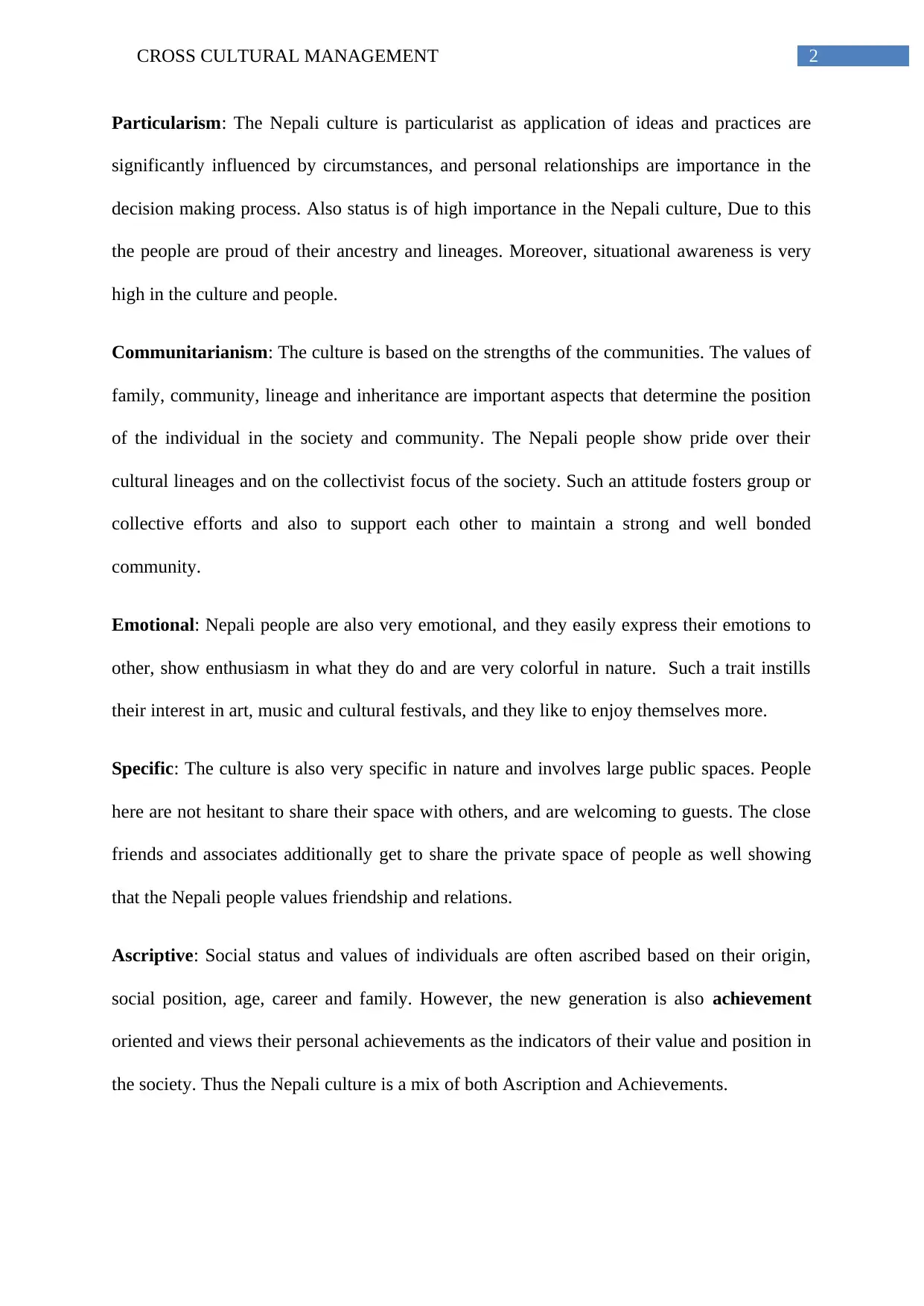
2CROSS CULTURAL MANAGEMENT
Particularism: The Nepali culture is particularist as application of ideas and practices are
significantly influenced by circumstances, and personal relationships are importance in the
decision making process. Also status is of high importance in the Nepali culture, Due to this
the people are proud of their ancestry and lineages. Moreover, situational awareness is very
high in the culture and people.
Communitarianism: The culture is based on the strengths of the communities. The values of
family, community, lineage and inheritance are important aspects that determine the position
of the individual in the society and community. The Nepali people show pride over their
cultural lineages and on the collectivist focus of the society. Such an attitude fosters group or
collective efforts and also to support each other to maintain a strong and well bonded
community.
Emotional: Nepali people are also very emotional, and they easily express their emotions to
other, show enthusiasm in what they do and are very colorful in nature. Such a trait instills
their interest in art, music and cultural festivals, and they like to enjoy themselves more.
Specific: The culture is also very specific in nature and involves large public spaces. People
here are not hesitant to share their space with others, and are welcoming to guests. The close
friends and associates additionally get to share the private space of people as well showing
that the Nepali people values friendship and relations.
Ascriptive: Social status and values of individuals are often ascribed based on their origin,
social position, age, career and family. However, the new generation is also achievement
oriented and views their personal achievements as the indicators of their value and position in
the society. Thus the Nepali culture is a mix of both Ascription and Achievements.
Particularism: The Nepali culture is particularist as application of ideas and practices are
significantly influenced by circumstances, and personal relationships are importance in the
decision making process. Also status is of high importance in the Nepali culture, Due to this
the people are proud of their ancestry and lineages. Moreover, situational awareness is very
high in the culture and people.
Communitarianism: The culture is based on the strengths of the communities. The values of
family, community, lineage and inheritance are important aspects that determine the position
of the individual in the society and community. The Nepali people show pride over their
cultural lineages and on the collectivist focus of the society. Such an attitude fosters group or
collective efforts and also to support each other to maintain a strong and well bonded
community.
Emotional: Nepali people are also very emotional, and they easily express their emotions to
other, show enthusiasm in what they do and are very colorful in nature. Such a trait instills
their interest in art, music and cultural festivals, and they like to enjoy themselves more.
Specific: The culture is also very specific in nature and involves large public spaces. People
here are not hesitant to share their space with others, and are welcoming to guests. The close
friends and associates additionally get to share the private space of people as well showing
that the Nepali people values friendship and relations.
Ascriptive: Social status and values of individuals are often ascribed based on their origin,
social position, age, career and family. However, the new generation is also achievement
oriented and views their personal achievements as the indicators of their value and position in
the society. Thus the Nepali culture is a mix of both Ascription and Achievements.
⊘ This is a preview!⊘
Do you want full access?
Subscribe today to unlock all pages.

Trusted by 1+ million students worldwide
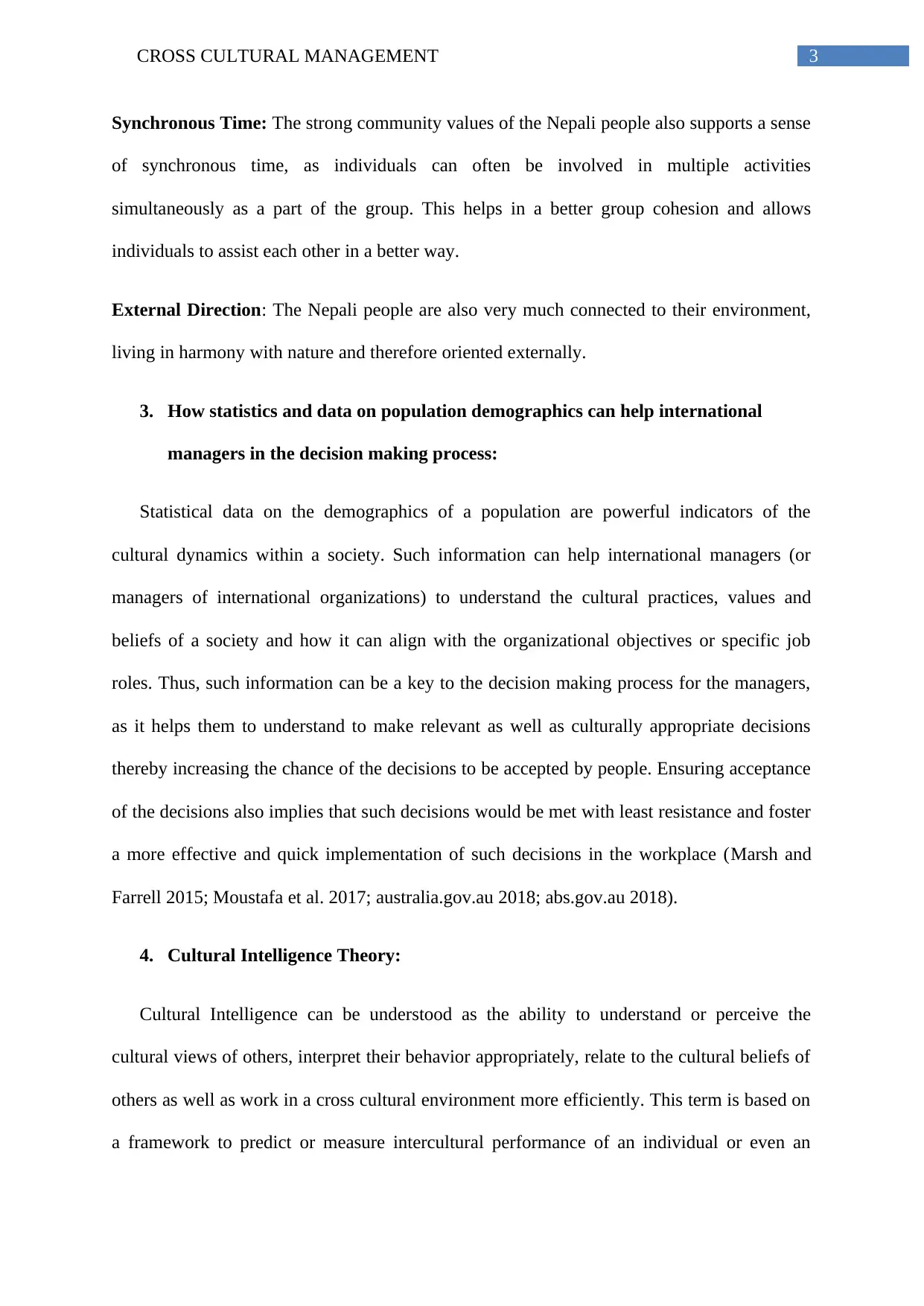
3CROSS CULTURAL MANAGEMENT
Synchronous Time: The strong community values of the Nepali people also supports a sense
of synchronous time, as individuals can often be involved in multiple activities
simultaneously as a part of the group. This helps in a better group cohesion and allows
individuals to assist each other in a better way.
External Direction: The Nepali people are also very much connected to their environment,
living in harmony with nature and therefore oriented externally.
3. How statistics and data on population demographics can help international
managers in the decision making process:
Statistical data on the demographics of a population are powerful indicators of the
cultural dynamics within a society. Such information can help international managers (or
managers of international organizations) to understand the cultural practices, values and
beliefs of a society and how it can align with the organizational objectives or specific job
roles. Thus, such information can be a key to the decision making process for the managers,
as it helps them to understand to make relevant as well as culturally appropriate decisions
thereby increasing the chance of the decisions to be accepted by people. Ensuring acceptance
of the decisions also implies that such decisions would be met with least resistance and foster
a more effective and quick implementation of such decisions in the workplace (Marsh and
Farrell 2015; Moustafa et al. 2017; australia.gov.au 2018; abs.gov.au 2018).
4. Cultural Intelligence Theory:
Cultural Intelligence can be understood as the ability to understand or perceive the
cultural views of others, interpret their behavior appropriately, relate to the cultural beliefs of
others as well as work in a cross cultural environment more efficiently. This term is based on
a framework to predict or measure intercultural performance of an individual or even an
Synchronous Time: The strong community values of the Nepali people also supports a sense
of synchronous time, as individuals can often be involved in multiple activities
simultaneously as a part of the group. This helps in a better group cohesion and allows
individuals to assist each other in a better way.
External Direction: The Nepali people are also very much connected to their environment,
living in harmony with nature and therefore oriented externally.
3. How statistics and data on population demographics can help international
managers in the decision making process:
Statistical data on the demographics of a population are powerful indicators of the
cultural dynamics within a society. Such information can help international managers (or
managers of international organizations) to understand the cultural practices, values and
beliefs of a society and how it can align with the organizational objectives or specific job
roles. Thus, such information can be a key to the decision making process for the managers,
as it helps them to understand to make relevant as well as culturally appropriate decisions
thereby increasing the chance of the decisions to be accepted by people. Ensuring acceptance
of the decisions also implies that such decisions would be met with least resistance and foster
a more effective and quick implementation of such decisions in the workplace (Marsh and
Farrell 2015; Moustafa et al. 2017; australia.gov.au 2018; abs.gov.au 2018).
4. Cultural Intelligence Theory:
Cultural Intelligence can be understood as the ability to understand or perceive the
cultural views of others, interpret their behavior appropriately, relate to the cultural beliefs of
others as well as work in a cross cultural environment more efficiently. This term is based on
a framework to predict or measure intercultural performance of an individual or even an
Paraphrase This Document
Need a fresh take? Get an instant paraphrase of this document with our AI Paraphraser
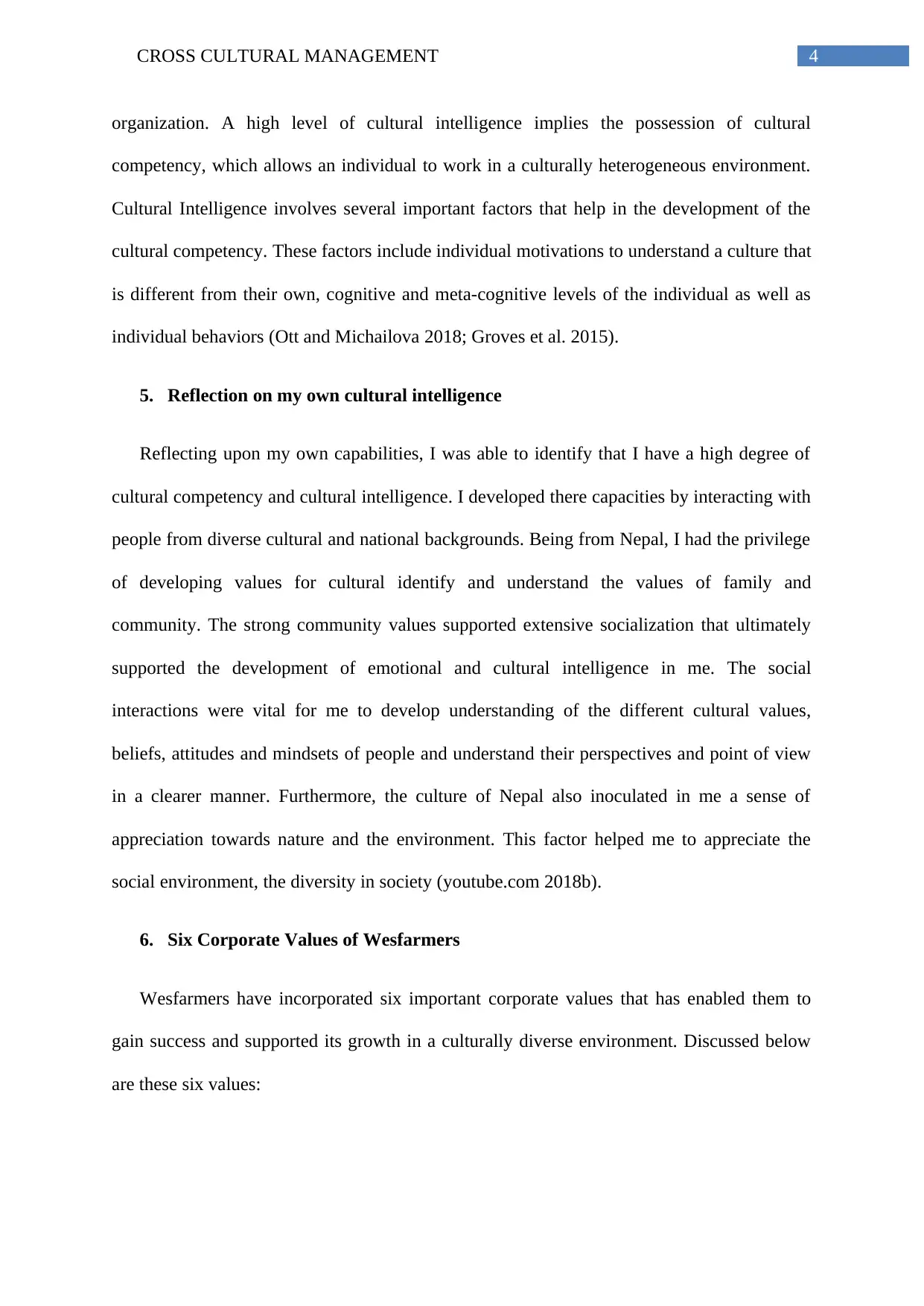
4CROSS CULTURAL MANAGEMENT
organization. A high level of cultural intelligence implies the possession of cultural
competency, which allows an individual to work in a culturally heterogeneous environment.
Cultural Intelligence involves several important factors that help in the development of the
cultural competency. These factors include individual motivations to understand a culture that
is different from their own, cognitive and meta-cognitive levels of the individual as well as
individual behaviors (Ott and Michailova 2018; Groves et al. 2015).
5. Reflection on my own cultural intelligence
Reflecting upon my own capabilities, I was able to identify that I have a high degree of
cultural competency and cultural intelligence. I developed there capacities by interacting with
people from diverse cultural and national backgrounds. Being from Nepal, I had the privilege
of developing values for cultural identify and understand the values of family and
community. The strong community values supported extensive socialization that ultimately
supported the development of emotional and cultural intelligence in me. The social
interactions were vital for me to develop understanding of the different cultural values,
beliefs, attitudes and mindsets of people and understand their perspectives and point of view
in a clearer manner. Furthermore, the culture of Nepal also inoculated in me a sense of
appreciation towards nature and the environment. This factor helped me to appreciate the
social environment, the diversity in society (youtube.com 2018b).
6. Six Corporate Values of Wesfarmers
Wesfarmers have incorporated six important corporate values that has enabled them to
gain success and supported its growth in a culturally diverse environment. Discussed below
are these six values:
organization. A high level of cultural intelligence implies the possession of cultural
competency, which allows an individual to work in a culturally heterogeneous environment.
Cultural Intelligence involves several important factors that help in the development of the
cultural competency. These factors include individual motivations to understand a culture that
is different from their own, cognitive and meta-cognitive levels of the individual as well as
individual behaviors (Ott and Michailova 2018; Groves et al. 2015).
5. Reflection on my own cultural intelligence
Reflecting upon my own capabilities, I was able to identify that I have a high degree of
cultural competency and cultural intelligence. I developed there capacities by interacting with
people from diverse cultural and national backgrounds. Being from Nepal, I had the privilege
of developing values for cultural identify and understand the values of family and
community. The strong community values supported extensive socialization that ultimately
supported the development of emotional and cultural intelligence in me. The social
interactions were vital for me to develop understanding of the different cultural values,
beliefs, attitudes and mindsets of people and understand their perspectives and point of view
in a clearer manner. Furthermore, the culture of Nepal also inoculated in me a sense of
appreciation towards nature and the environment. This factor helped me to appreciate the
social environment, the diversity in society (youtube.com 2018b).
6. Six Corporate Values of Wesfarmers
Wesfarmers have incorporated six important corporate values that has enabled them to
gain success and supported its growth in a culturally diverse environment. Discussed below
are these six values:
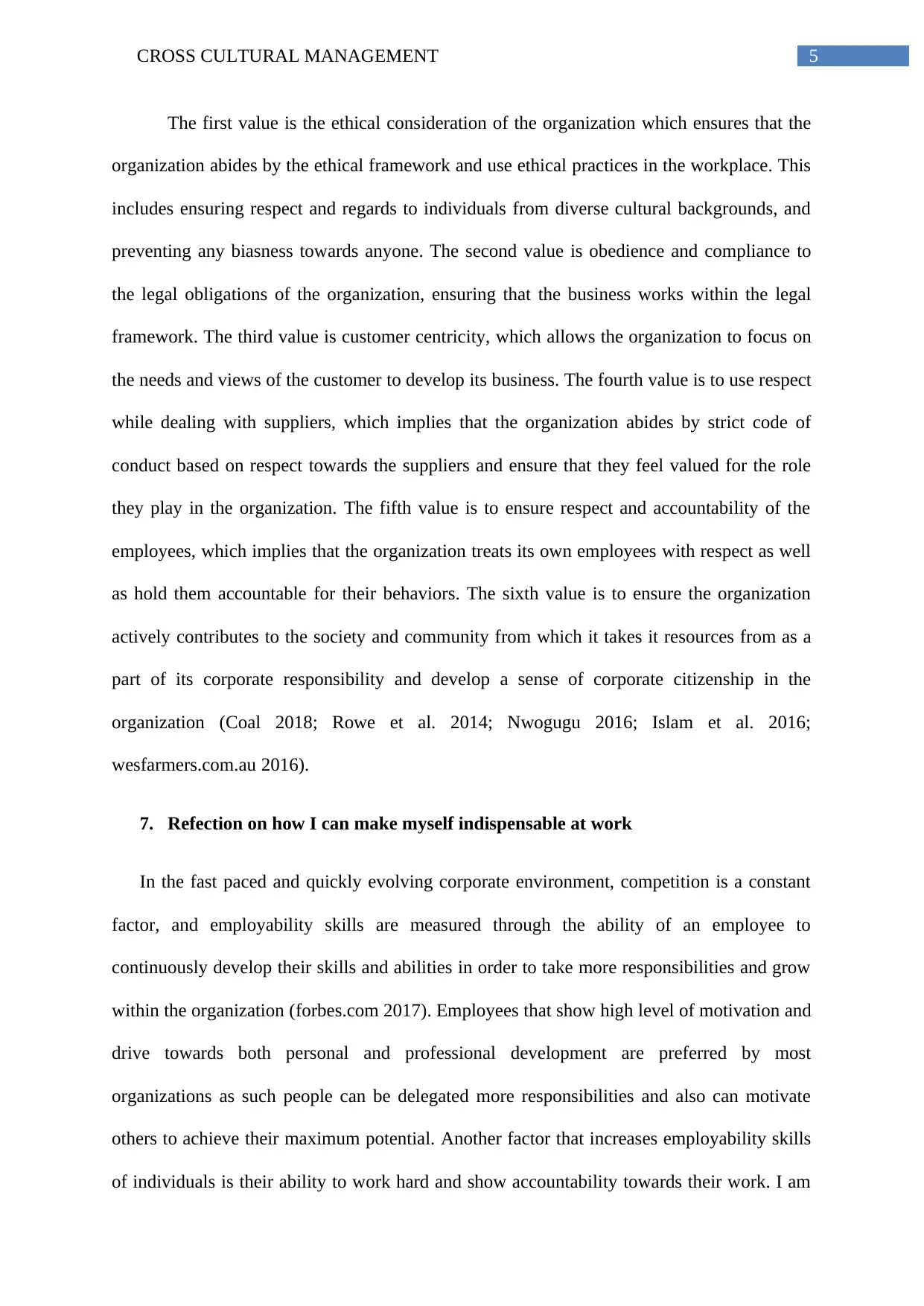
5CROSS CULTURAL MANAGEMENT
The first value is the ethical consideration of the organization which ensures that the
organization abides by the ethical framework and use ethical practices in the workplace. This
includes ensuring respect and regards to individuals from diverse cultural backgrounds, and
preventing any biasness towards anyone. The second value is obedience and compliance to
the legal obligations of the organization, ensuring that the business works within the legal
framework. The third value is customer centricity, which allows the organization to focus on
the needs and views of the customer to develop its business. The fourth value is to use respect
while dealing with suppliers, which implies that the organization abides by strict code of
conduct based on respect towards the suppliers and ensure that they feel valued for the role
they play in the organization. The fifth value is to ensure respect and accountability of the
employees, which implies that the organization treats its own employees with respect as well
as hold them accountable for their behaviors. The sixth value is to ensure the organization
actively contributes to the society and community from which it takes it resources from as a
part of its corporate responsibility and develop a sense of corporate citizenship in the
organization (Coal 2018; Rowe et al. 2014; Nwogugu 2016; Islam et al. 2016;
wesfarmers.com.au 2016).
7. Refection on how I can make myself indispensable at work
In the fast paced and quickly evolving corporate environment, competition is a constant
factor, and employability skills are measured through the ability of an employee to
continuously develop their skills and abilities in order to take more responsibilities and grow
within the organization (forbes.com 2017). Employees that show high level of motivation and
drive towards both personal and professional development are preferred by most
organizations as such people can be delegated more responsibilities and also can motivate
others to achieve their maximum potential. Another factor that increases employability skills
of individuals is their ability to work hard and show accountability towards their work. I am
The first value is the ethical consideration of the organization which ensures that the
organization abides by the ethical framework and use ethical practices in the workplace. This
includes ensuring respect and regards to individuals from diverse cultural backgrounds, and
preventing any biasness towards anyone. The second value is obedience and compliance to
the legal obligations of the organization, ensuring that the business works within the legal
framework. The third value is customer centricity, which allows the organization to focus on
the needs and views of the customer to develop its business. The fourth value is to use respect
while dealing with suppliers, which implies that the organization abides by strict code of
conduct based on respect towards the suppliers and ensure that they feel valued for the role
they play in the organization. The fifth value is to ensure respect and accountability of the
employees, which implies that the organization treats its own employees with respect as well
as hold them accountable for their behaviors. The sixth value is to ensure the organization
actively contributes to the society and community from which it takes it resources from as a
part of its corporate responsibility and develop a sense of corporate citizenship in the
organization (Coal 2018; Rowe et al. 2014; Nwogugu 2016; Islam et al. 2016;
wesfarmers.com.au 2016).
7. Refection on how I can make myself indispensable at work
In the fast paced and quickly evolving corporate environment, competition is a constant
factor, and employability skills are measured through the ability of an employee to
continuously develop their skills and abilities in order to take more responsibilities and grow
within the organization (forbes.com 2017). Employees that show high level of motivation and
drive towards both personal and professional development are preferred by most
organizations as such people can be delegated more responsibilities and also can motivate
others to achieve their maximum potential. Another factor that increases employability skills
of individuals is their ability to work hard and show accountability towards their work. I am
⊘ This is a preview!⊘
Do you want full access?
Subscribe today to unlock all pages.

Trusted by 1+ million students worldwide
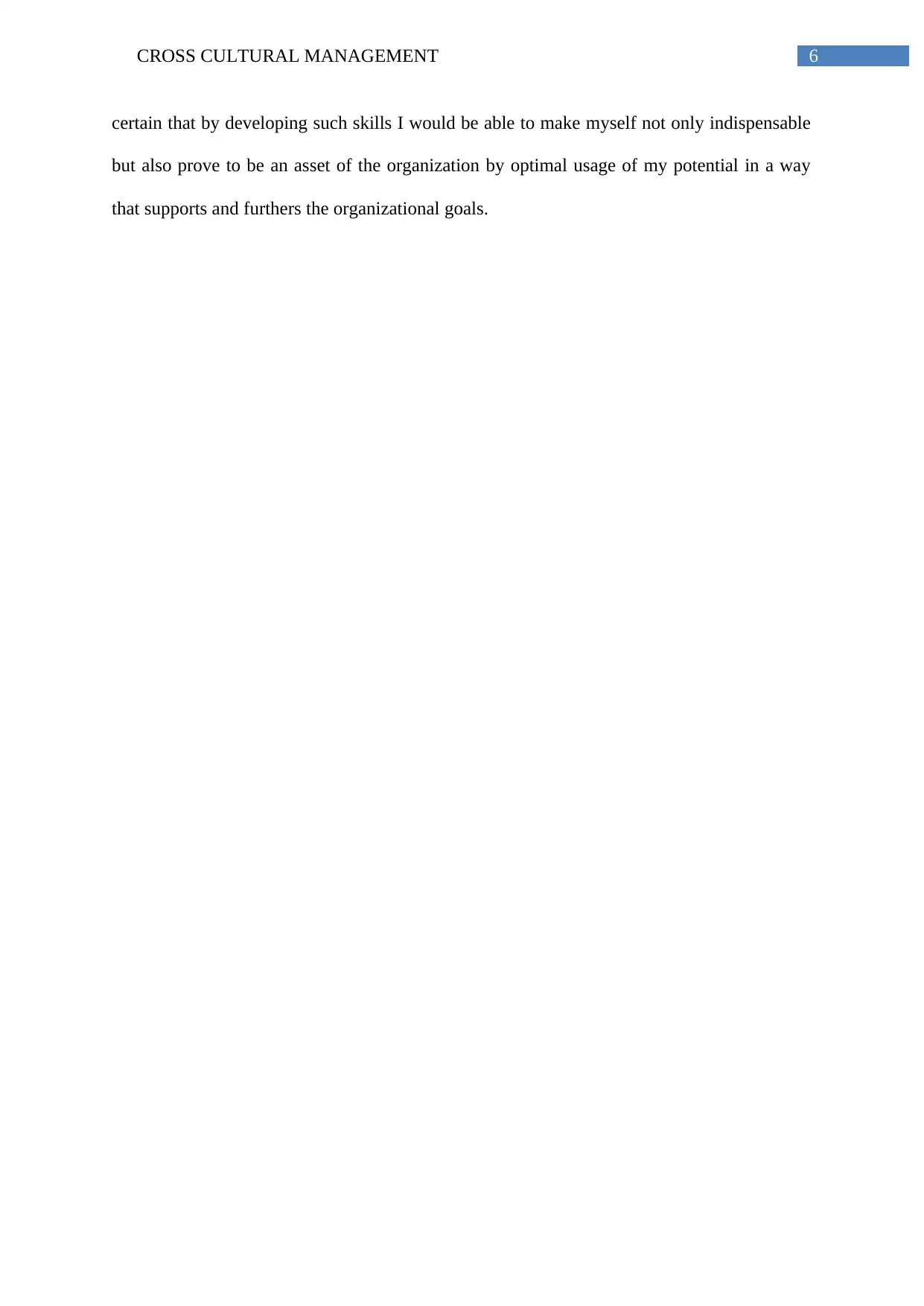
6CROSS CULTURAL MANAGEMENT
certain that by developing such skills I would be able to make myself not only indispensable
but also prove to be an asset of the organization by optimal usage of my potential in a way
that supports and furthers the organizational goals.
certain that by developing such skills I would be able to make myself not only indispensable
but also prove to be an asset of the organization by optimal usage of my potential in a way
that supports and furthers the organizational goals.
Paraphrase This Document
Need a fresh take? Get an instant paraphrase of this document with our AI Paraphraser
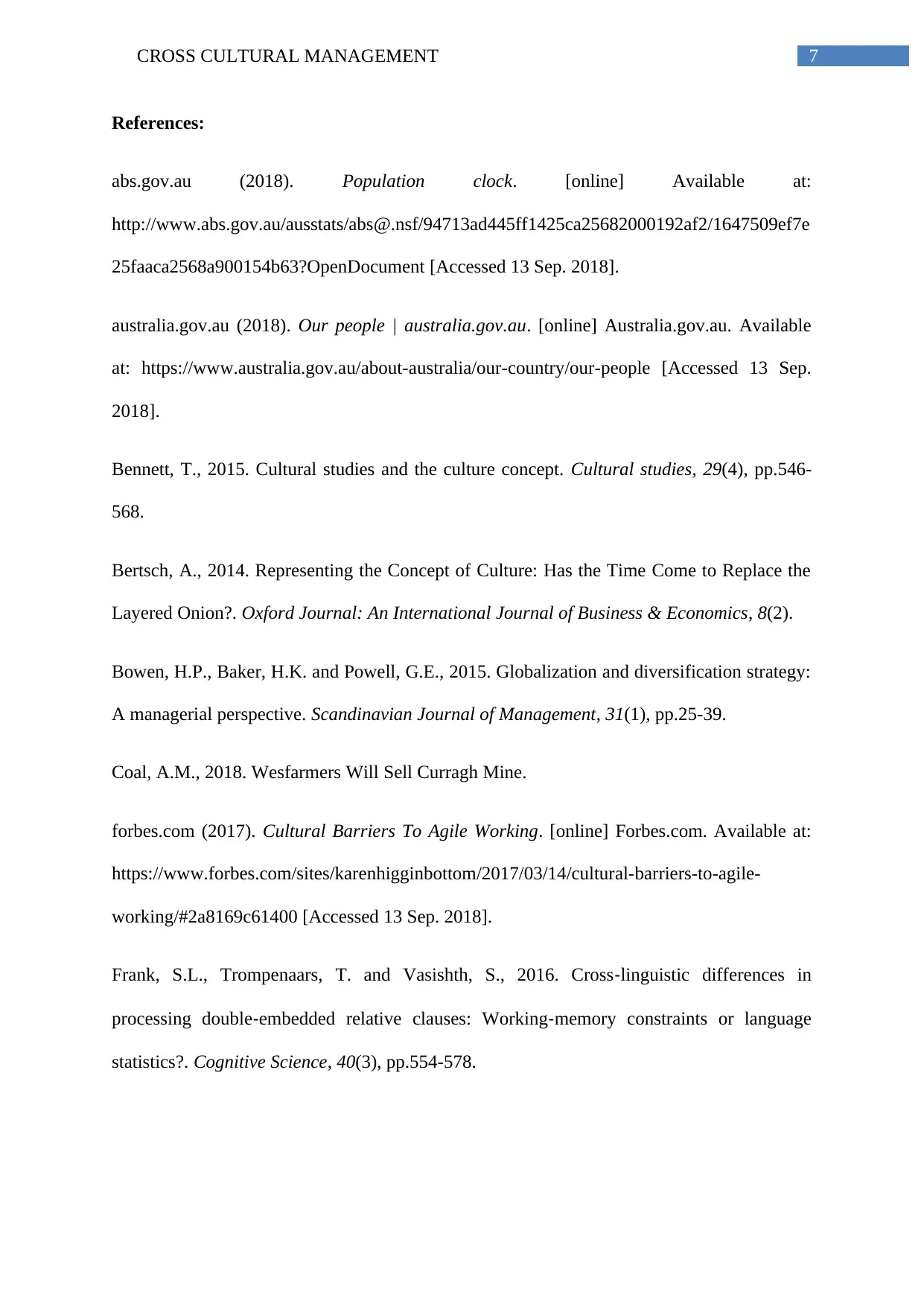
7CROSS CULTURAL MANAGEMENT
References:
abs.gov.au (2018). Population clock. [online] Available at:
http://www.abs.gov.au/ausstats/abs@.nsf/94713ad445ff1425ca25682000192af2/1647509ef7e
25faaca2568a900154b63?OpenDocument [Accessed 13 Sep. 2018].
australia.gov.au (2018). Our people | australia.gov.au. [online] Australia.gov.au. Available
at: https://www.australia.gov.au/about-australia/our-country/our-people [Accessed 13 Sep.
2018].
Bennett, T., 2015. Cultural studies and the culture concept. Cultural studies, 29(4), pp.546-
568.
Bertsch, A., 2014. Representing the Concept of Culture: Has the Time Come to Replace the
Layered Onion?. Oxford Journal: An International Journal of Business & Economics, 8(2).
Bowen, H.P., Baker, H.K. and Powell, G.E., 2015. Globalization and diversification strategy:
A managerial perspective. Scandinavian Journal of Management, 31(1), pp.25-39.
Coal, A.M., 2018. Wesfarmers Will Sell Curragh Mine.
forbes.com (2017). Cultural Barriers To Agile Working. [online] Forbes.com. Available at:
https://www.forbes.com/sites/karenhigginbottom/2017/03/14/cultural-barriers-to-agile-
working/#2a8169c61400 [Accessed 13 Sep. 2018].
Frank, S.L., Trompenaars, T. and Vasishth, S., 2016. Cross‐linguistic differences in
processing double‐embedded relative clauses: Working‐memory constraints or language
statistics?. Cognitive Science, 40(3), pp.554-578.
References:
abs.gov.au (2018). Population clock. [online] Available at:
http://www.abs.gov.au/ausstats/abs@.nsf/94713ad445ff1425ca25682000192af2/1647509ef7e
25faaca2568a900154b63?OpenDocument [Accessed 13 Sep. 2018].
australia.gov.au (2018). Our people | australia.gov.au. [online] Australia.gov.au. Available
at: https://www.australia.gov.au/about-australia/our-country/our-people [Accessed 13 Sep.
2018].
Bennett, T., 2015. Cultural studies and the culture concept. Cultural studies, 29(4), pp.546-
568.
Bertsch, A., 2014. Representing the Concept of Culture: Has the Time Come to Replace the
Layered Onion?. Oxford Journal: An International Journal of Business & Economics, 8(2).
Bowen, H.P., Baker, H.K. and Powell, G.E., 2015. Globalization and diversification strategy:
A managerial perspective. Scandinavian Journal of Management, 31(1), pp.25-39.
Coal, A.M., 2018. Wesfarmers Will Sell Curragh Mine.
forbes.com (2017). Cultural Barriers To Agile Working. [online] Forbes.com. Available at:
https://www.forbes.com/sites/karenhigginbottom/2017/03/14/cultural-barriers-to-agile-
working/#2a8169c61400 [Accessed 13 Sep. 2018].
Frank, S.L., Trompenaars, T. and Vasishth, S., 2016. Cross‐linguistic differences in
processing double‐embedded relative clauses: Working‐memory constraints or language
statistics?. Cognitive Science, 40(3), pp.554-578.
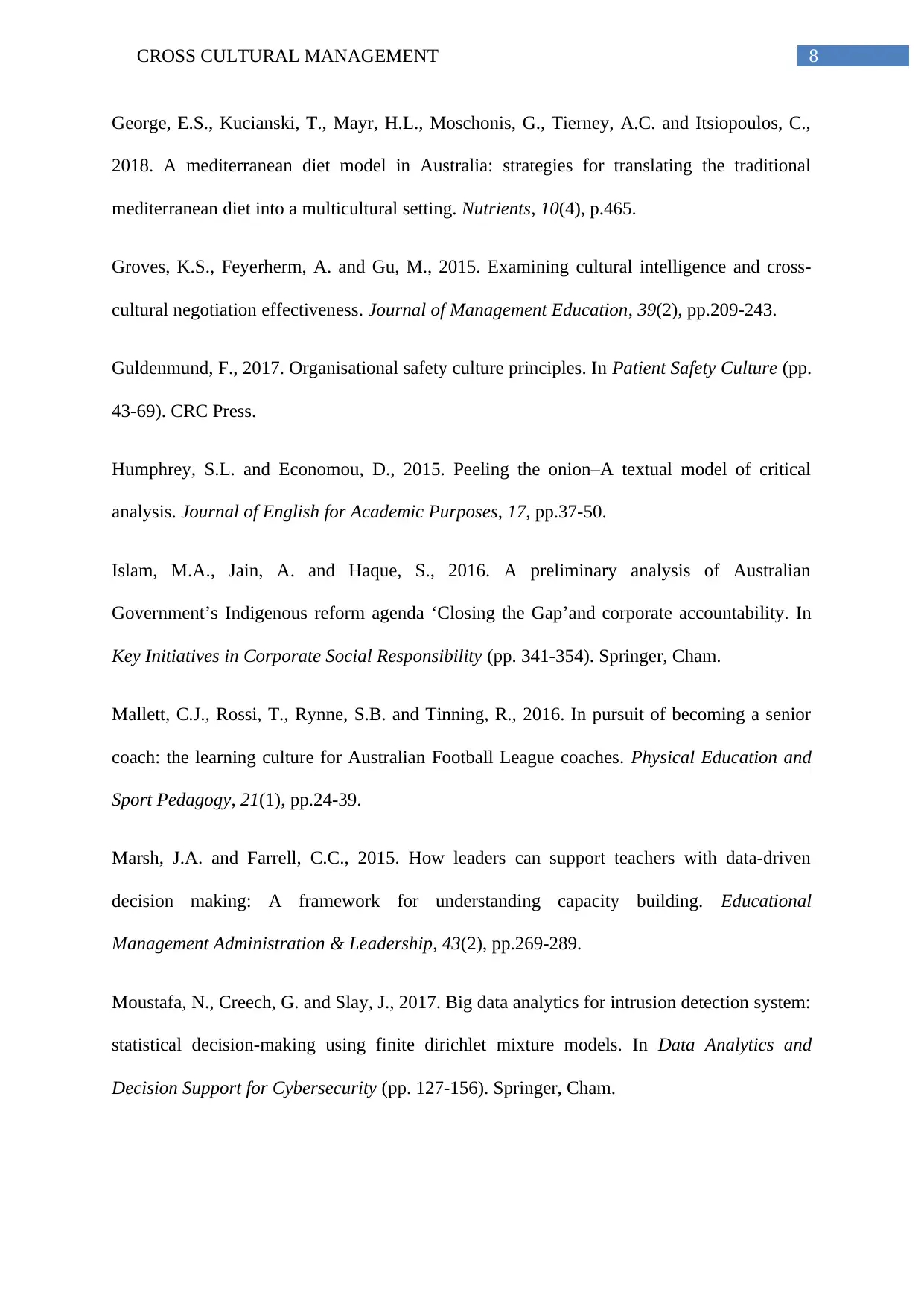
8CROSS CULTURAL MANAGEMENT
George, E.S., Kucianski, T., Mayr, H.L., Moschonis, G., Tierney, A.C. and Itsiopoulos, C.,
2018. A mediterranean diet model in Australia: strategies for translating the traditional
mediterranean diet into a multicultural setting. Nutrients, 10(4), p.465.
Groves, K.S., Feyerherm, A. and Gu, M., 2015. Examining cultural intelligence and cross-
cultural negotiation effectiveness. Journal of Management Education, 39(2), pp.209-243.
Guldenmund, F., 2017. Organisational safety culture principles. In Patient Safety Culture (pp.
43-69). CRC Press.
Humphrey, S.L. and Economou, D., 2015. Peeling the onion–A textual model of critical
analysis. Journal of English for Academic Purposes, 17, pp.37-50.
Islam, M.A., Jain, A. and Haque, S., 2016. A preliminary analysis of Australian
Government’s Indigenous reform agenda ‘Closing the Gap’and corporate accountability. In
Key Initiatives in Corporate Social Responsibility (pp. 341-354). Springer, Cham.
Mallett, C.J., Rossi, T., Rynne, S.B. and Tinning, R., 2016. In pursuit of becoming a senior
coach: the learning culture for Australian Football League coaches. Physical Education and
Sport Pedagogy, 21(1), pp.24-39.
Marsh, J.A. and Farrell, C.C., 2015. How leaders can support teachers with data-driven
decision making: A framework for understanding capacity building. Educational
Management Administration & Leadership, 43(2), pp.269-289.
Moustafa, N., Creech, G. and Slay, J., 2017. Big data analytics for intrusion detection system:
statistical decision-making using finite dirichlet mixture models. In Data Analytics and
Decision Support for Cybersecurity (pp. 127-156). Springer, Cham.
George, E.S., Kucianski, T., Mayr, H.L., Moschonis, G., Tierney, A.C. and Itsiopoulos, C.,
2018. A mediterranean diet model in Australia: strategies for translating the traditional
mediterranean diet into a multicultural setting. Nutrients, 10(4), p.465.
Groves, K.S., Feyerherm, A. and Gu, M., 2015. Examining cultural intelligence and cross-
cultural negotiation effectiveness. Journal of Management Education, 39(2), pp.209-243.
Guldenmund, F., 2017. Organisational safety culture principles. In Patient Safety Culture (pp.
43-69). CRC Press.
Humphrey, S.L. and Economou, D., 2015. Peeling the onion–A textual model of critical
analysis. Journal of English for Academic Purposes, 17, pp.37-50.
Islam, M.A., Jain, A. and Haque, S., 2016. A preliminary analysis of Australian
Government’s Indigenous reform agenda ‘Closing the Gap’and corporate accountability. In
Key Initiatives in Corporate Social Responsibility (pp. 341-354). Springer, Cham.
Mallett, C.J., Rossi, T., Rynne, S.B. and Tinning, R., 2016. In pursuit of becoming a senior
coach: the learning culture for Australian Football League coaches. Physical Education and
Sport Pedagogy, 21(1), pp.24-39.
Marsh, J.A. and Farrell, C.C., 2015. How leaders can support teachers with data-driven
decision making: A framework for understanding capacity building. Educational
Management Administration & Leadership, 43(2), pp.269-289.
Moustafa, N., Creech, G. and Slay, J., 2017. Big data analytics for intrusion detection system:
statistical decision-making using finite dirichlet mixture models. In Data Analytics and
Decision Support for Cybersecurity (pp. 127-156). Springer, Cham.
⊘ This is a preview!⊘
Do you want full access?
Subscribe today to unlock all pages.

Trusted by 1+ million students worldwide
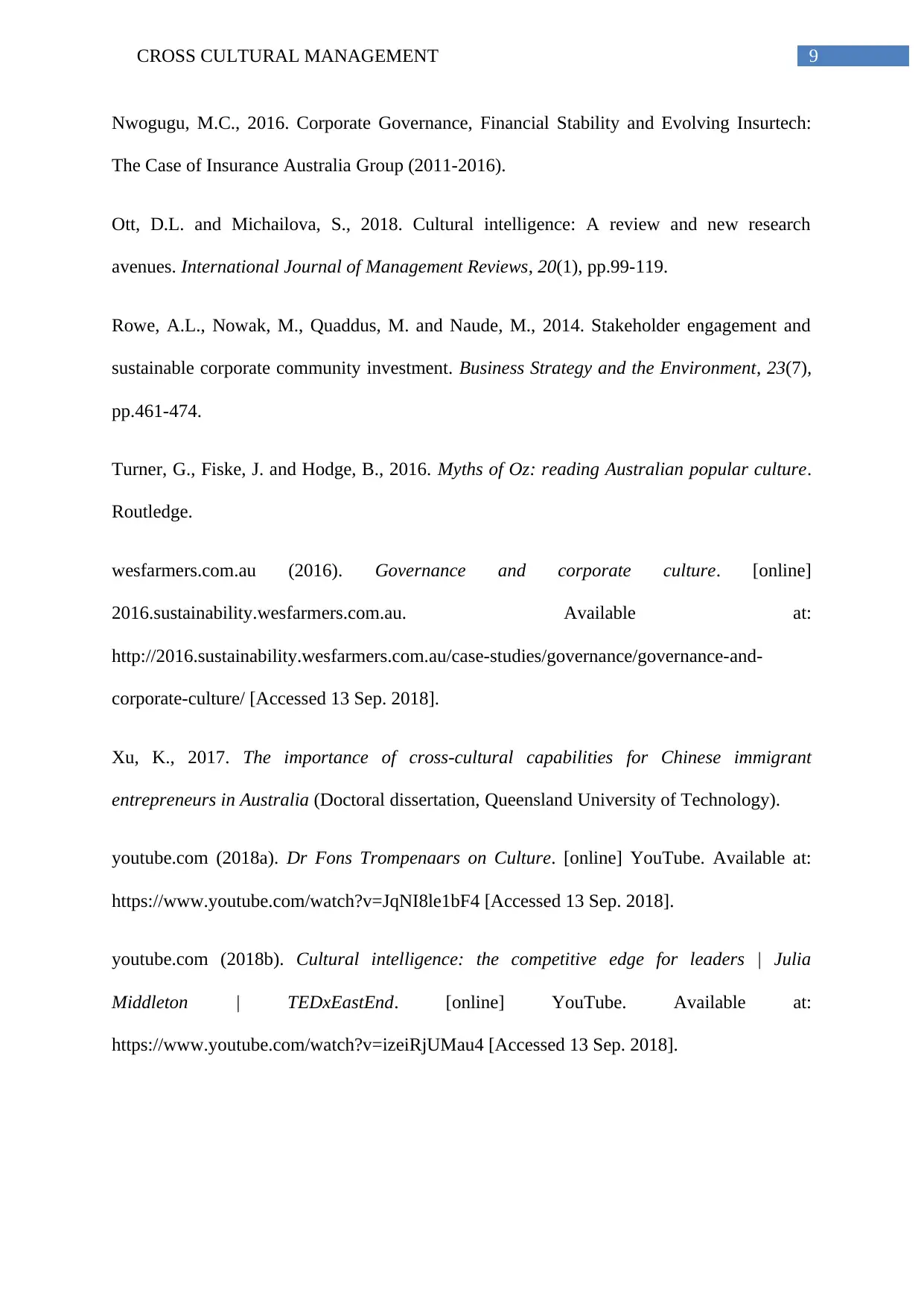
9CROSS CULTURAL MANAGEMENT
Nwogugu, M.C., 2016. Corporate Governance, Financial Stability and Evolving Insurtech:
The Case of Insurance Australia Group (2011-2016).
Ott, D.L. and Michailova, S., 2018. Cultural intelligence: A review and new research
avenues. International Journal of Management Reviews, 20(1), pp.99-119.
Rowe, A.L., Nowak, M., Quaddus, M. and Naude, M., 2014. Stakeholder engagement and
sustainable corporate community investment. Business Strategy and the Environment, 23(7),
pp.461-474.
Turner, G., Fiske, J. and Hodge, B., 2016. Myths of Oz: reading Australian popular culture.
Routledge.
wesfarmers.com.au (2016). Governance and corporate culture. [online]
2016.sustainability.wesfarmers.com.au. Available at:
http://2016.sustainability.wesfarmers.com.au/case-studies/governance/governance-and-
corporate-culture/ [Accessed 13 Sep. 2018].
Xu, K., 2017. The importance of cross-cultural capabilities for Chinese immigrant
entrepreneurs in Australia (Doctoral dissertation, Queensland University of Technology).
youtube.com (2018a). Dr Fons Trompenaars on Culture. [online] YouTube. Available at:
https://www.youtube.com/watch?v=JqNI8le1bF4 [Accessed 13 Sep. 2018].
youtube.com (2018b). Cultural intelligence: the competitive edge for leaders | Julia
Middleton | TEDxEastEnd. [online] YouTube. Available at:
https://www.youtube.com/watch?v=izeiRjUMau4 [Accessed 13 Sep. 2018].
Nwogugu, M.C., 2016. Corporate Governance, Financial Stability and Evolving Insurtech:
The Case of Insurance Australia Group (2011-2016).
Ott, D.L. and Michailova, S., 2018. Cultural intelligence: A review and new research
avenues. International Journal of Management Reviews, 20(1), pp.99-119.
Rowe, A.L., Nowak, M., Quaddus, M. and Naude, M., 2014. Stakeholder engagement and
sustainable corporate community investment. Business Strategy and the Environment, 23(7),
pp.461-474.
Turner, G., Fiske, J. and Hodge, B., 2016. Myths of Oz: reading Australian popular culture.
Routledge.
wesfarmers.com.au (2016). Governance and corporate culture. [online]
2016.sustainability.wesfarmers.com.au. Available at:
http://2016.sustainability.wesfarmers.com.au/case-studies/governance/governance-and-
corporate-culture/ [Accessed 13 Sep. 2018].
Xu, K., 2017. The importance of cross-cultural capabilities for Chinese immigrant
entrepreneurs in Australia (Doctoral dissertation, Queensland University of Technology).
youtube.com (2018a). Dr Fons Trompenaars on Culture. [online] YouTube. Available at:
https://www.youtube.com/watch?v=JqNI8le1bF4 [Accessed 13 Sep. 2018].
youtube.com (2018b). Cultural intelligence: the competitive edge for leaders | Julia
Middleton | TEDxEastEnd. [online] YouTube. Available at:
https://www.youtube.com/watch?v=izeiRjUMau4 [Accessed 13 Sep. 2018].
1 out of 10
Related Documents
Your All-in-One AI-Powered Toolkit for Academic Success.
+13062052269
info@desklib.com
Available 24*7 on WhatsApp / Email
![[object Object]](/_next/static/media/star-bottom.7253800d.svg)
Unlock your academic potential
Copyright © 2020–2025 A2Z Services. All Rights Reserved. Developed and managed by ZUCOL.


